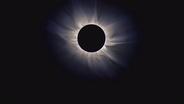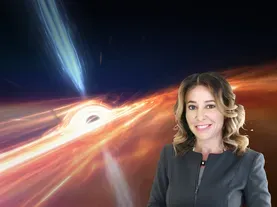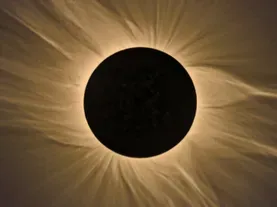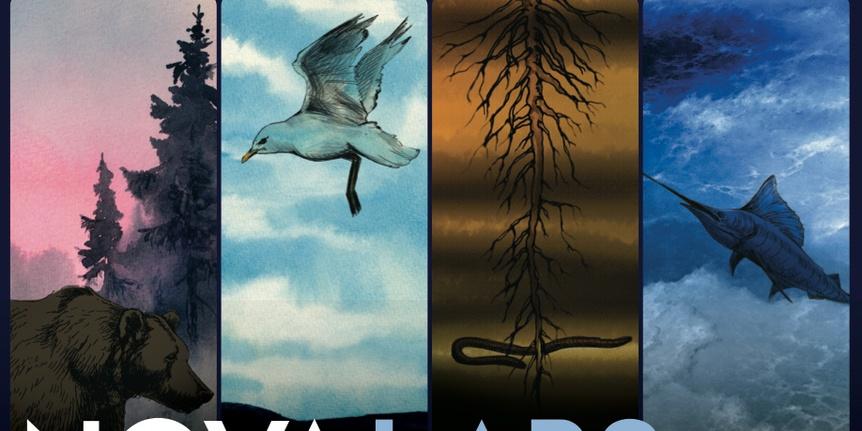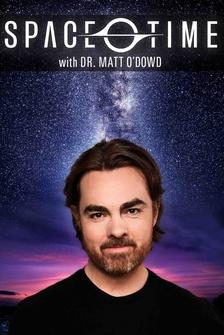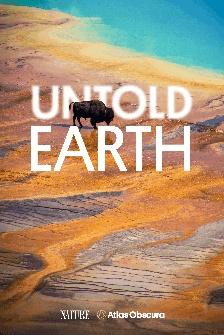♪ ♪ NARRATOR: A total solar eclipse.
(people talking in background) NARRATOR: It's a rare and astonishing natural phenomenon.
♪ ♪ HAKEEM OLUSEYI: Seeing a total solar eclipse is, like, "What?!"
You know, you just never forget it.
♪ ♪ NARRATOR: Solar eclipses have filled people with wonder since the earliest times.
It connects us with the past, our predecessors.
They observed the same thing we see today whenever we look at an eclipse.
(cheers) AMIR CASPI: You feel a connection.
I am a part of the universe, I am a part of the solar system, I am a part of this celestial event.
NARRATOR: Can scientists seize these precious moments of darkness to explore a region of the sun normally invisible... ...its outer atmosphere, the solar corona?
GRANT TREMBLAY: The solar corona is one of the great keyholes to peer into, to truly understand the behavior of the sun.
NARRATOR: Behaviors like violent eruptions from the corona can cause huge solar storms.
MICHAEL WONG: The largest solar storms could really destabilize most of the world's technology.
NARRATOR: Plunging cities into darkness.
With the help of eclipses, can researchers decode these dangerous blasts and, one day, learn to predict them?
ANJALI TRIPATHI: It's completely extraordinary that nature gives us this opportunity to turn off the lights.
NARRATOR: While millions will enjoy the spectacle, scientists are among the most avid eclipse chasers, studying the sun on the ground, in the air, and touching the corona itself.
Their goal: to better understand our most important celestial neighbor.
"Great American Eclipse."
Right now, on "NOVA."
♪ ♪ NARRATOR: It's one of nature's greatest spectacles.
OLUSEYI: A total solar eclipse is like the universe just walked up to your door and said, "Hey!
Here I am!
I'm dynamic, and I'm doing stuff!"
♪ ♪ NARRATOR: And on April 8, 2024, everybody in the lower 48 states can experience at least a partial solar eclipse-- weather permitting.
♪ ♪ For the 31.5 million people who live in the path of totality, the disc of the sun will completely disappear.
TRIPATHI: It's very emotional.
The world stops for a moment, and you are surrounded by a completely different universe.
♪ ♪ ♪ ♪ NARRATOR: A total solar eclipse only happens because of an astonishing coincidence.
♪ ♪ The Earth, moon, and sun must perfectly align, so the moon blocks the sun's light.
♪ ♪ The diameter of the moon is around 400 times smaller than that of the sun.
But the moon also just so happens to be roughly 400 times closer to the Earth, so it appears the same size in the sky as the sun.
When it passes in front of the sun, it blocks the sun's light, casting a shadow on the Earth that plunges everywhere it passes into darkness.
CASPI: That experience is surreal.
It is not like any other experience that a human being can have.
NARRATOR: At 11:07 a.m. local time on Monday, April 8, the darkest part of the moon's shadow hits Mexico's Pacific Coast.
Traveling at more than 1,500 miles an hour, the shadow is over 100 miles wide, passing over Dallas at 1:40 p.m., through Arkansas and Illinois, over Indianapolis at 3:06 p.m. and Buffalo at 3:18 p.m. local time.
This shadow will exit continental North America at 4:38 p.m., after touching 15 U.S. states.
TRIPATHI: It's a completely extraordinary coincidence that we get the angles just right to make this work.
If we were anywhere else in the solar system, we would not have this perfect alignment.
NARRATOR: And if the moon were any closer to Earth or any larger, it would completely obscure the object the scientists are trying to study... ...the sun's outer atmosphere.
It's called the corona.
(people talking in background) NARRATOR: During a total eclipse, the corona comes into view as the moon passes in front of the sun.
So the moon has just made contact and started covering the sun's disc, and we call that first contact.
And then, the disc of the moon slides down and covers the disc of the sun.
And we call that second contact.
This is the magic moment, this is what we're all waiting for in a total solar eclipse.
This is totality.
The entire disc of the sun is covered, and that allows the sun's atmosphere that we call the corona to emerge and be visible.
It just... (makes sound effect) ...pops out, and you're just, like... (gasps): Wow!
♪ ♪ NARRATOR: But scientists on the ground only get a chance to study the corona if they're in the right spot and if the weather cooperates.
The bane of every eclipse chaser is clouds and other weather that keep them from seeing totality.
♪ ♪ NARRATOR: Statistically, Mexico should have the clearest skies along the path of totality during April, with Texas a runner-up.
But most places north of Missouri have less than 50% chance of clear skies.
Standing on the center-line of the moon's shadow gives you the most time to view the corona.
The last total solar eclipse to pass across the U.S. was in 2017.
It was an unforgettable spectacle, witnessed by an estimated 215 million people.
But the maximum duration of totality was just two minutes and 42 seconds.
(crowd cheering) NARRATOR: In 2024, the maximum duration is almost twice as long, lasting four minutes and 28 seconds.
♪ ♪ During the eclipse, that gives you a really unique opportunity to suddenly see this corona and to study it scientifically.
The corona is less bright-- quite a lot less bright-- than the main part of the sun, so, normally, when you observe the sun, you're not able to see that corona.
♪ ♪ NARRATOR: The sun is so bright that until the moon completely covers it, the only way to view it safely is to use certified solar filters or eclipse-viewing glasses.
(crowd cheering and clapping) TRIPATHI: It's really exciting to watch.
But there is this real danger of blinding yourself, or causing significant eye damage.
WONG: You've got to get these special eclipse glasses, this special eyewear, that block out 99.999% of the sunlight and virtually all of the U.V.
light that would really damage your eyes.
♪ ♪ NARRATOR: The human eye has a lens.
It helps focus light onto the retina, which contains over 100 million light-sensitive receptor cells.
These cells translate light into electrical signals that the brain can read as images.
Staring directly at the sun, the focused beam from the lens becomes so intense, it can easily burn the cells in the retina, leaving a permanent blind spot.
♪ ♪ Eclipse glasses will prevent this.
But the magnifying effect of telescopes and binoculars can still destroy your eye.
So, you see what that light did to these viewing glasses?
It would do the same thing to your eye.
You'd blind yourself instantly.
Even if you're wearing certified solar viewing glasses, you cannot look through a telescope with them unless there is a telescopic solar filter on the telescope itself.
♪ ♪ TRIPATHI: During totality, that total darkness, you can actually take off your solar glasses and stare at the sun for just a brief moment and appreciate that darkness, with that coronal light around it, which is one of these amazing moments that you can only experience if you're actually witnessing total solar eclipse.
♪ ♪ NARRATOR: But on April 8, what about the people who are not lucky enough to live within or travel to the path of totality?
What can they see?
The good news is that nearly everyone in the U.S. lower 48 has a chance to experience at least a partial eclipse.
♪ ♪ You see roughly ten percent more of the sun with every 200 miles of distance from the path of totality.
For example, in Atlanta, Georgia, the moon covers just over 80% of the sun's disc.
In Los Angeles, California, around 50%.
While in Portland, Oregon, just over 20% of the sun is blocked.
♪ ♪ Imagine looking up at the sky-- with proper eye protection-- and noticing that part of the sun has gone missing.
That is the joy and wonder of a partial solar eclipse.
So even if you don't experience total darkness, you are still experiencing this wondrous phenomenon.
♪ ♪ NARRATOR: But only the darkness of a total eclipse allows us to see the sun's outer atmosphere, the corona.
The corona's elusive, pearly-white cloud is made from a state of matter rarely found on Earth called plasma.
OLUSEYI: Sometimes we call plasma the fourth state of matter.
There are many different states of matter, but the ones we're accustomed to here on Earth are four: solids, liquids, gases, and plasmas.
NARRATOR: If you heat a gas to a high enough temperature, some of the electrons in its atoms fly off, leaving positively charged ions.
This super-hot mixture of ions and electrons is known as a plasma.
We don't see plasmas very often on Earth.
Very briefly, as part of a lightning bolt, there'll be a plasma.
(lightning crashing, thunder booming) But the sun, especially its corona, is this incredible plasma.
♪ ♪ NARRATOR: Although rare on Earth, plasma is a common state of matter in the visible universe.
The stars we see in the sky are made from it, including our sun.
With 1.3 million times more volume than Earth, our sun is a dense ball of plasma, made from hydrogen, helium, and smaller amounts of other elements.
The heat that creates this plasma is generated in the sun's core.
Here, the extreme heat and pressure force the hydrogen nuclei to fuse together, creating helium and releasing vast amounts of energy as photons.
This nuclear fusion heats the core to 27 million degrees Fahrenheit.
From here, the photons pass through the dense inner layer of the sun.
♪ ♪ The temperature of the plasma gradually drops, as the photons reach the sun's visible surface, known as the photosphere.
♪ ♪ Here, rising and sinking plasma forms a seething surface of light and dark areas.
Around the photosphere is the corona, the sun's outer atmosphere of extremely diffuse plasma, extending far into space.
WONG: The corona is called the corona because it sort of has this crown-like shape, and "corona" in Latin is the word for crown.
It's thin and wispy, and hence very dim compared to the actual surface of the sun, so we need that surface to be blocked in order to see the corona.
♪ ♪ NARRATOR: But what more could science discover if we could get closer?
(machine whirring loudly) In 2018, NASA launches a pioneering space probe to do exactly that.
It's called the Parker Solar Probe.
Onboard are instruments that will change our understanding of the sun and study its extreme behavior.
(people talking in background) KELLY KORRECK: Parker Solar Probe was conceived in 1958.
There was a big, long wait because our technology was trying to catch up with our dreams.
MAN: Go Delta.
MAN 2: Go PSP.
♪ ♪ (inaudible) look good and in full thrust mode.
♪ ♪ KORRECK: Solar flares are large magnetic eruptions which can cause particles to come streaming towards the Earth.
We also have coronal mass ejections, which are billions of tons of material, equivalent to 80 million school buses, racing towards us at millions of miles an hour that can do things like interfere with satellites or affect our power grid.
NARRATOR: But even when the sun is quiet, a lower-intensity, steady outflow of charged solar particles forms what's called solar wind.
♪ ♪ KORRECK: It has been a mystery as to why that wind is accelerating constantly off the solar surface.
(engine roaring) Parker Solar Probe is named for Eugene Parker, a very dear man who had a theory about the origins of the solar wind.
That paper laid the groundwork for the study of the solar wind that we know today.
♪ ♪ Parker is the fastest human-made object.
It'll reach speeds of 430,000 miles per hour.
NARRATOR: A four-and-a-half-inch-thick heat shield made from a carbon composite, painted with heat-reflecting ceramic paint, protects the probe.
KORRECK: The top heat shield is going to experience 1,300 degrees Celsius, and in the back, it's going to be room temperature.
It's important to have this huge temperature difference.
Those instruments in the back need to operate in about room temperature.
NARRATOR: Since 2018, the probe's elongated orbit takes it progressively closer and closer to the sun.
♪ ♪ And in December 2021, the team announces a major breakthrough.
♪ ♪ KORRECK: Parker Solar Probe had touched the sun.
This is definitely a first.
This is the monumental achievement of being able to say that we were inside the atmosphere of a star.
♪ ♪ NARRATOR: Some scientists assumed the sun's atmosphere was smooth, like a ball.
This is the boundary where the solar wind escapes the sun's gravity and magnetic pull, and spills out into space.
But Parker's data shows it is undulating, complex, and dynamic.
As the probe barrels through the sun's atmosphere, it runs into huge magnetic structures rising from the surface, called coronal pseudo-streamers.
These could be responsible for the rugged edge of the sun's atmosphere.
KORRECK: The particles of the solar wind are a plasma.
We are just beginning to learn more and more about how they're thrown out of the sun.
Knowing the shape of that surface is really important to understand the formation and acceleration of the solar wind towards us.
♪ ♪ NARRATOR: The strength of the solar wind depends on the behavior of the sun's magnetic field, which varies according to an 11-year cycle called the solar cycle.
And according to that pattern, the expected activity in 2024 could make the April eclipse particularly interesting for scientists.
KORRECK: In 2017, the sun was at a minimum.
In 2024, the difference is going to be that the sun will be very active.
It will be at a maximum.
And those maximums are where you get the show.
There could be a lot of activity going on.
My dream is that there is actually a coronal mass ejection or a flare going off that we could see.
That would be exciting.
♪ ♪ NARRATOR: Solar eclipses have captivated communities in North America for centuries.
Three hours northwest of what is now Albuquerque, this canyon was once home to the Chacoans, a Pueblo Native American people who farmed the land here until the 13th century.
♪ ♪ Jon Ghahate believes they were closely attuned to the sun's movements and rhythms.
GHAHATE: What makes the Pueblo communities different from our neighbors throughout this entire region is that they were permanent agrarian societies.
To be an agrarian society, that takes a great deal of planning and problem solving.
If I plant too late, I may not get a bountiful harvest.
If I plant too early, maybe I'll get a late frost.
So by being able to have an understanding of what timing means, as it applies to the seasons, is essential for survival.
NARRATOR: At the top of nearby Fajada Butte, the Chacoans tracked the sun to measure the seasons.
GHAHATE: There were some slabs that project sunlight on a spiral.
On the equinox, the light hits a certain point on that, and that's why it's called the Sun Dagger.
NARRATOR: The equinoxes mark the moments in the year when day and night are of roughly equal length.
Knowing when these happen is vital for deciding when to plant and when to harvest.
♪ ♪ But the Sun Dagger is not the only evidence the Chacoans watched the skies closely.
There's also a mysterious petroglyph here that suggests people on this continent may have witnessed eclipses that have passed across North America over centuries.
You see the circular symbol here?
Perhaps that represents the sun in totality.
Around the symbol, we see lines or curvatures, which perhaps we could interpret as maybe the corona of the sun or the flares of the sun that perhaps someone might see in a total eclipse.
NARRATOR: Scientists today can calculate that in 1097, a total eclipse was visible here while the sun was nearing the peak of its solar cycle-- solar maximum, when vast plumes would have extended from the corona.
GHAHATE: That's the tantalizing thing about it.
Much like whenever we have an eclipse in our time and age, people stop work, people want to go outside to record this monumental event, because it's something unique and special.
It connects us with the past.
Those are the same celestial bodies that our predecessors saw.
We're just really the same as they were.
We just have different tools.
♪ ♪ NARRATOR: There are 574 recognized Indigenous communities across the U.S., with varying perspectives on solar eclipses.
The Navajo people consider an eclipse to be a moment of renewal that can be harmful if viewed.
Cherokee tradition says a giant frog is swallowing the sun, and the frog must be scared away to bring back the daylight.
(wind howling) For the casual observer, the timing and location of eclipses can appear random.
After the April 2024 total solar eclipse, it will be 20 years until another is visible from the U.S. lower 48.
(people talking in background) NARRATOR: However, the period of time between total eclipses can be much shorter.
FILM NARRATOR: Nature cooperating with ballyhoo.
Elaborate preparations were made.
NARRATOR: In 1925, American astronomers watched a total eclipse as it passed from the middle of the country to the east coast.
Some even flew in an airship to make observations.
♪ ♪ This fortunate generation had already seen two total solar eclipses in the previous seven years, and would see another only seven years later.
♪ ♪ (people talking in background) NARRATOR: Despite this apparent randomness, there is a complex pattern behind eclipses.
And, astonishingly, it was discovered over 2,000 years ago.
Ancient Babylon, situated in what is now modern Iraq.
For centuries, astronomers here recorded every occasion an eclipse was reported.
Eventually, around the seventh century BC, they spotted a pattern.
♪ ♪ OSSENDRIJVER: Some very clever Babylonian astronomers figured out that solar eclipses are governed by a cycle.
This is the so-called saros cycle.
NARRATOR: Today, we know that a total solar eclipse will take place somewhere on Earth about once every 18 months.
But with centuries of data, the Babylonians realized there was a larger pattern.
Every 18 years, the time between eclipses would repeat.
OSSENDRIJVER: They could actually make an entire calendar of eclipse predictions simply by projecting these past eclipses into the future.
NARRATOR: Astonishingly, the Babylonian predictions were accurate to within an average of four hours.
But they couldn't tell where in the world the eclipse would take place.
♪ ♪ It would be another 2,000 years before astronomers figured out how to do that.
TYLER NORDGREN: In 1715, the British astronomer Edmond Halley became the first person to correctly predict a total solar eclipse by using the mathematics of his good friend Isaac Newton to calculate the orbit of the moon around the Earth, and therefore, where its shadow would fall across the countryside.
NARRATOR: In April 1715, Halley published this map, forecasting that two weeks later, an eclipse would pass over Great Britain.
Halley had studied records of past eclipses, and rediscovered the saros cycle, lost since ancient times.
This told him an eclipse was due.
He then used new, accurate observations of the moon's orbit to calculate its path.
Among the things he had to take into account was the unusual orbit of the moon... ...which is tilted by five degrees.
So most of the time, the moon's shadow misses our planet, which makes eclipses rare.
He also had to factor in the gravitational effect of the Earth and the sun, which subtly alters the moon's position.
Just 28 years earlier, Newton had proposed his new theory of gravity, which allowed Halley to accurately calculate the path of the eclipse.
NORDGREN: From comparing the maps that Edmond Halley made of the 1715 eclipse, both before and after, based on the observations by the public, we find that he was actually within about 20 miles.
Amazingly precise.
NARRATOR: And Halley's estimate of the time of the eclipse was off by just four minutes.
♪ ♪ Today, with more accurate observations of the moon's orbit, astronomers can predict exactly where an eclipse will occur to the nearest hundred feet, and when to the nearest tenth of a second.
This is how they know the precise path of the 2024 total eclipse years ahead of time.
The dance between Earth, moon, and sun is predictable.
But the sun itself-- and its corona-- are chaotic.
Coronal mass ejections can disrupt our power supplies and destroy our communications technologies.
So learning how to predict coronal mass ejections is the Holy Grail of solar physics.
The sun is not some static, unchanging ball of gas, right?
It is ejecting parts of itself into the solar system.
The solar corona is this dynamic and ever-changing and incredibly beautiful halo of plasma around the sun.
It's so important in so many ways.
NARRATOR: The lines of plasma in the sun's corona are vast.
They would dwarf the Earth.
The force that drives their shape and motion... ...is the sun's magnetic field.
Earth also has a magnetic field.
It's formed by our planet's spinning liquid metal core and gives us our magnetic north and south poles.
But the sun has even stronger magnetic fields, created by the movement of electrically charged particles churning beneath the surface.
Because the plasma is moving faster in some regions, these fields bend and twist... ...until some break through the sun's photosphere into the corona, where they form giant arches called coronal loops.
Because these magnetic fields trap electrically charged particles, they show up as the bright lines and loops of plasma we see in the corona.
But these field lines can snap.
TREMBLAY: The plasma is now free of its chains, its anchors from the sun, and it's free to blast off into space.
NARRATOR: In a coronal mass ejection, the corona can throw a billion tons of plasma out into space... ...at speeds of almost 2,000 miles per second.
When a coronal mass ejection heads our way, Earth's own magnetic field normally deflects it, protecting the planet.
But a large coronal mass ejection can overwhelm our magnetic defenses with devastating consequences.
OLUSEYI: A coronal mass ejection can stream toward the Earth and disrupt our technologies, burn out power stations, damage sensors on satellites, wreaking havoc, so, we really need to be able to predict these things.
♪ ♪ NARRATOR: In June 2023, the Parker Solar Probe makes a giant leap towards understanding the mechanisms that project solar material towards us.
The probe flies close enough to the surface of the sun to examine the origins of the solar wind.
♪ ♪ The sun's surface is a superheated honeycomb of churning plasma cells, each the size of Texas.
Here, magnetic plasma loops get dragged around and collide, triggering explosions that release vast amounts of energy and catapult streams of plasma away from the sun.
Scientists have calculated there are thousands of these "jetlets" all over the sun's surface-- proof that they can give birth to the solar wind.
This was a theory as to how some of the solar wind was formed.
As Parker got closer, it showed that this theory is actually at work.
When Eugene Parker proposed these theories, they seemed like science fiction, and now they're becoming science fact.
NARRATOR: Soon, a new NASA mission, called PUNCH, will launch four cameras that will orbit Earth to continuously map not only how the solar wind flows towards and around our planet, but also across the entire solar system.
So that's from space... NARRATOR: Craig DeForest leads the team.
But it doesn't rule out... DEFOREST: The four cameras separate out all the way around the world, looking out in different directions.
We synchronize them, so they're snapping pictures at the exact same time to image those clouds of material in all directions, in three dimensions, as they streak across the solar system, sweeping out and past us.
With a system like PUNCH, we would be able to track the events all the way across the solar system.
This is revolutionary.
We expect to be able to greatly improve forecasting of space weather.
♪ ♪ NARRATOR: Back on Earth, in October 2023, Craig gears up to test a new version of an old instrument that, for the first time, could make the sun's elusive and violent corona visible to any of us at any time.
It's called a coronagraph.
DEFOREST: What a coronagraph does is interpose a manmade object in front of a telescope so that we can block out the sun, just like the moon would do, and see the corona around it.
NARRATOR: But coronagraphs have limitations.
It's almost impossible to block enough of the sun's light to see the corona, unless they are either incredibly precise and expensive or they are deployed in space, above the Earth's light-scattering atmosphere.
It allows the camera to see a perfectly uniform field of view.
NARRATOR: The team hopes to produce the first-ever coronagraph that anyone can download, 3D-print, and fit onto a telescope at home.
No, there you go-- that's it.
Oh, there it is, perfect.
We expect to refine the design and be able to publish a design that will access the corona on any sunny day.
NARRATOR: To help them test this device, the team has chosen a special day.
Over Albuquerque, New Mexico, today, there will be an annular solar eclipse.
♪ ♪ The moon's orbit is not a perfect circle.
It's very slightly elliptical.
So, when the moon is farther from the Earth, it appears smaller, and doesn't completely cover the sun, creating an annular eclipse, also known as a "ring of fire" eclipse.
We have a special case, where the moon does 90% of the work.
The sky is much darker.
(people talking in background) NARRATOR: By complete chance, the annular eclipse coincides with the Albuquerque International Balloon Fiesta-- the world's largest gathering of balloonists.
Today, we have 550 balloons in this beautiful Albuquerque sky.
We'll have somewhere between 800,000 and one million come through our gates.
We just got really lucky when we saw that the eclipse was going to coincide with our event.
We couldn't be happier.
JUDITH NAKAMURA: I think the crowd is going to be in awe of getting to witness this once-in-a-lifetime event, because it's not happened here before.
We just have to thank Mother Nature and the calendar lining up together.
So we are about to have first contact.
Three, two, one-- oh, yeah, you see it.
Right on the top.
WOMAN: Ooh, and there's a bite!
♪ ♪ NARRATOR: As the moon begins to line up with the sun, everything starts to get... weird.
WOMAN: Because the sun is turning into a crescent sun, the shadows change shape.
So it's one of the most eerie things about an eclipse, is the shadows changing shape.
♪ ♪ All right, we have annularity.
(crowd cheers and applauds) MAN: All right.
(people talking, exclaiming in background) So cool!
CHILD: This is so beautiful!
(people talking in background) CHILD 1: Lookit!
CHILD 2: It's a perfect circle!
NAKAMURA: What a spectacular, awesome sight.
Thank you, Mother Nature.
Thank you, Mother Nature, and thank you, Balloon Fiesta.
DEFOREST: This is phenomenal!
The visceral reactions that you feel during the approach and during the annularity itself are, it's very hard to describe.
It's, it's very moving.
(mouths) DEFOREST: Annular eclipses are phenomenal.
If you can ever get to the path of a total solar eclipse, it is incredible and life-changing.
We won't know until we analyze the data that we got today just how much of the corona we saw.
So if you look, if I turn this thing on and off... (murmurs) So this is our coronagraph.
Look at that-- they seem to line up.
Perfect.
So I think we've seen the corona.
Yeah, I mean, I think that there's a really good possibility.
♪ ♪ DEFOREST: What we're looking at is the very first data, and what we found is, yes, it looks to me like it's the corona.
We're not done yet-- we have more analysis to do.
We've really just begun.
♪ ♪ NARRATOR: During the April 2024 total eclipse, amateur astronomers will work with scientists to study how the corona changes in real time.
(people talking in background) CASPI: Citizen scientists, or community participants, they're going to get training and we're going to deploy them all along the eclipse path, from the very edge of the United States in Texas all the way to the other edge in Maine, where they will be able to observe the eclipse shadow passing over each one of them.
And that way, we can put together all of their observations into one hourlong movie of totality.
And so that gives us information about how the corona is evolving and changing over a period of one hour.
♪ ♪ NARRATOR: These citizen scientists may play a role in solving one of the most enduring mysteries of the corona.
♪ ♪ In the late 1800s, a team of astronomers studying the corona during an eclipse made a surprising discovery.
In 1869, there was a total solar eclipse visible from the United States.
Charles Young, an astronomer at Dartmouth College, led an expedition to Iowa in order to use the brand-new technology of spectroscopy.
NARRATOR: A spectroscope uses a prism to divide white light into its constituent colors, or wavelengths.
If you heat an element enough, its gas emits light in very specific wavelengths.
Viewed through a spectroscope, each element has its own unique pattern of colored lines.
♪ ♪ By pointing a spectroscope at the corona during an eclipse, Young hoped to find the elements it contained.
What he discovered was a mysterious spectral line no one had ever seen coming from any element on Earth.
NORDGREN: He noticed there was a special green line-- green light emitted from the corona.
And since it matched up with no known element, people naturally assumed that there must be some new element not existing here on the Earth that had been discovered.
NARRATOR: Scientists gave this strange new element a name: coronium, because it had been discovered in the corona.
NORDGREN: For the next 70 years, astronomers sought to identify what this mystery element might be.
What they found, in fact, was that it was a known element: iron.
Iron at such a high temperature, that 13 of its 26 electrons had been ripped away.
NARRATOR: Astonishingly, the corona was so hot, it had turned the metal iron into a plasma with a spectral line completely different from iron found on Earth.
NORDGREN: Only under extraordinarily high temperatures is this ever possible, so when you see a total solar eclipse, and you witness that amazing corona, you are seeing the hottest thing you will ever see with the human eye.
NARRATOR: The corona is about two million degrees.
And that's a problem.
The surface of the sun is only about 10,000 degrees.
How can the sun's outer atmosphere be hotter than its surface?
It seems to defy basic laws of physics.
♪ ♪ Back in 2017, in search of answers, scientists came up with a plan to not only extend viewing time, but also avoid any clouds that might obscure the eclipse.
Amir Caspi and his team fly two NASA jet aircraft fitted with telescopes above the clouds, and track the eclipse from an altitude of 50,000 feet.
CASPI: By getting above 90% of the atmosphere, above 90% of the water vapor, we can access wavelengths that we normally wouldn't be able to on the ground.
NARRATOR: They hoped their data might shed light on why the corona is so much hotter than the surface of the sun.
CASPI: And the idea is that they pick up the track and follow the track straight through... NARRATOR: The jets could not keep up with the eclipse shadow traveling around 1,500 miles an hour, more than three times as fast as the planes.
But by flying two jets along the path of the eclipse, Amir extended the viewing time to over seven minutes.
The instruments aboard Amir's jets could image the infrared radiation emitted by the corona in high resolution.
JENNA SAMRA: Infrared radiation is special because it allows us to probe the corona's magnetic field, and the corona's magnetic field is critically important for pretty much everything that happens in the solar corona.
NARRATOR: The infrared images of magnetic structures in the corona collected by Amir and his team in 2017 gave some unexpected results.
One of the things that we noticed is that, structures called prominences.
This is material from the solar chromosphere, the layer just above the surface.
Its temperature is only 10,000, 20,000 degrees Celsius.
Other structures, what we call active regions, those are at millions of degrees.
And we saw that prominences and active regions were glowing with approximately equal brightness in the infrared images.
That's something that boggled our minds, because they are a hundred times different in temperatures, so how could they be glowing at the same intensity?
NARRATOR: What are the physical mechanisms that cause these dramatically different regions to emit infrared equally?
2024 gives us a new opportunity to study the corona and answer some of the questions that we opened in 2017.
NARRATOR: In 2024, can new instruments making even more detailed measurements of infrared radiation help us explain these surprising observations?
Here's your incoming vector, right?
NARRATOR: Jenna Samra is looking for clues.
She and her team have built their own spectroscope that also measures the exact brightness of the infrared light.
And they'll install this sensitive equipment onboard a Gulfstream V jet to track the eclipse from the air.
Models suggest there are infrared wavelengths where the corona emits light that we've not yet detected with instruments.
These could eventually help us measure the corona's magnetic field, which stores the energy that heats the corona.
SAMRA: Physicists have predicted a number of these bright wavelengths, called emission lines, and our spectrum should encompass about 20 of these, and about half of these have never been seen before.
NARRATOR: Jenna wants to find those missing lines.
But what if they aren't there?
Would that mean the physicists' predictions are wrong?
For now, they're just at the start of their investigation.
Our instrument is going to be a stepping stone for understanding the, the physics of the corona, including predicting solar flares and coronal mass ejections.
NARRATOR: But in a jet moving at over 500 miles per hour, how can you keep the eclipse perfectly centered so the spectroscope can take reliable measurements?
SAMRA: The apparent position of the sun starts moving around.
So this mirror actually tracks the sun.
It's moving a thousand times a second to basically take out the turbulence of the airplane.
The mirror is auto-correcting.
It's getting a signal from the camera, it's saying, "Oh, the sun has moved off of center.
Bring it back to center."
NARRATOR: While Earth-bound scientists are limited to studying this eclipse from one angle, viewing from space will give scientists an entirely different perspective on how the sun's corona and its magnetic fields are shifting, heating, and cooling during the eclipse.
The Parker Solar Probe will be looking at the sun from 90 degrees in relation to the rest of us here on Earth during the 2024 eclipse.
This will give multiple perspectives on the corona and allow scientists to compare real-time data from different angles.
KORRECK: I'm so excited for the 2024 eclipse.
It's been a long time coming to really understand our star, the sun.
NARRATOR: With clear weather, spectators under the path of the eclipse can enjoy totality for almost four-and-a-half minutes.
But as the moon begins to reveal the sun, further cosmic treats await.
Here's the thing about the moon-- it's not a smooth ball.
There are mountains, there are valleys.
So between those valleys and peaks, you get light of the sun peeking through, and those little bright dots look like a string of beads.
We call that Baily's beads.
So we can actually see the topography of the moon illustrated and amplified by the light from the sun.
NARRATOR: As more sunlight creeps around the edge of the moon, there's one final, astonishing display.
Then you have this big bright spot, and this is known as the diamond ring.
It is stunning.
It's beautiful, and you don't want to miss it.
(crowd cheering and applauding) NARRATOR: The 2024 eclipse can teach us more than ever before about our nearest star that gives us life on Earth.
Total solar eclipses are amazing celestial events to see, and it's just awe-inspiring to experience something so extraordinary.
DEFOREST: We are in a golden age right now of solar physics.
♪ ♪ Our understanding of what the sun is doing is going to evolve dramatically.
NARRATOR: Countless people around the world and across millennia have gazed with wonder and awe as the sun disappears.
It's how we as human beings interpret this event that has been going on as long as human beings have been on this planet.
TREMBLAY: Let me tell you, you have never seen a shadow this spectacular.
It is a truly remarkable event, because you'd have to wait years for the next total eclipse to go over your head.
NARRATOR: 31.5 million people live in the path of totality, a rare moment when the celestial dance comes home.
You don't want to miss this opportunity to see the eclipse.
Yeah, don't miss it!
(laughs) ♪ ♪ ♪ ♪ ♪ ♪ ♪ ♪ ♪ ♪ ♪ ♪
